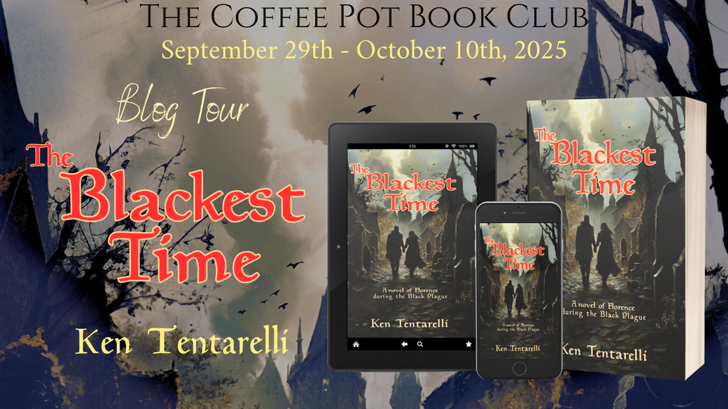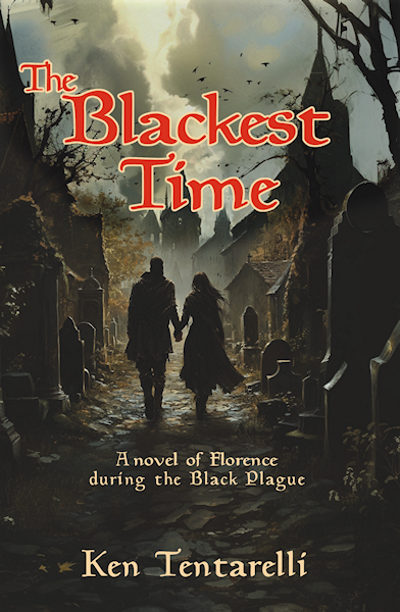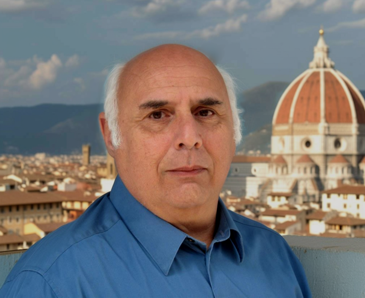
Set in the 1300s during the devastating black plague, The Blackest Time is a powerful tale of compassion, love, and the human spirit’s ability to endure immense adversity.
Gino, the central character, is a young man who leaves his family’s farm to find work in a pharmacy in Florence. His experiences show us how people coped in the most horrific time in history.
Shortly after Gino arrived in the city, two years of incessant rain destroyed crops in the countryside, leading to famine and despair in the city. Gino offers hope and help to the suffering— he secures shelter for a woman forced to leave her flooded farm, rescues a young girl orphaned by the plague, and aids others who have lost everything.
The rains had barely ended when the plague hit the city, exposing the true character of its people. While some blamed others for the devastation, the story focuses on the compassionate acts of neighbors helping each other overcome fear and suffering. Doctors bravely risk infection to care for their patients. A woman healer, wrongly accused of witchcraft and driven from the city, finds a new beginning in a village where her skills were appreciated.
Despite the hardships, love blossoms between Gino and a young woman he met at the apothecary. Together they survive, finding strength in each other and hope in a world teetering on the edge.
The Blackest Time is a testament to the strength of the human spirit in overcoming unimaginable tragedy.

Guest Post: Treating the Black Plague
Since the time of Hippocrates, nearly two thousand years before the time of the Black Plague, physicians practiced the art of balancing bodily fluids as the treatment for curing the sick and preventing illness. Ancient Greeks, Romans, and Medieval people thought four elements made up the body: blood, phlegm, black bile and yellow bile. Similar to today, medical practitioners took urine samples from their patients, but rather than using laboratory tests to determine a diagnosis, Medieval doctors believed they could detect imbalances by smelling the samples.
Their common remedies for many ailments were potions or salves made from herbs, flowers, or even crushed minerals like or arsenic. In my novel, The Blackest Time, Gino, the main character, works in an apothecary shop in Florence where he creates medicines from plants and flowers he gathers in the hills surrounding the city.
Some conditions called for harsher treatment. Patients diagnosed as having an excess of blood were treated with bloodletting, a technique whereby doctors drained blood using leeches or cuts until the fluids were in balance.
When the black plague struck Florence, doctors quickly found their remedies could not cure the afflicted. They continued using the techniques on family members of those stricken, hoping they could contain the spread of the disease. Since their existing techniques were ineffective doctors tried other approaches. The plague manifested itself as painful swellings on the neck and armpits. Doctors tried draining the swellings, a technique both ineffective and unsanitary.
A widely held belief was that the plague was caused by bad air. People sought to eliminate the foul air by wearing perfume. In the novel, Gino sells gardenia perfume to men and women who want the strongest possible scent. Doctors went further by fumigating patients’ homes with smoke from aromatic herbs. Quacks, who hawked elixirs and bizarre remedies in the city’s central market, sold vinegar solutions for bathing, urine for drinking, and other often harmful treatments. [The first effective treatments for the black plague weren’t developed until the 1890s.]
Once people realized the plague couldn’t be cured, efforts shifted toward making the afflicted more comfortable in their few remaining days. In Florence, the nominally 200 bed hospital, Ospedale di Santa Maria Nuova, grew to over 300 beds at the plague’s peak. It offered both spiritual and basic care, including individual food and medicine, cleanliness, constant nursing, and access to doctors. Nurses were constantly on duty to look after the sick and meet their needs. Beds were kept clean to provide a healthier environment for the sick. The secular staff at the hospital cared for patients spiritually as well as physically. While Ospedale di Santa Maria Nuova wasn’t specifically a plague hospital, it provided some of the best support in Florence during the crisis.
Healthy people began isolating themselves from the sick and those who might have been exposed to the disease. Individuals practiced social distancing. Those accustomed to spending time with their friends and relatives stopped doing so. Governments created policies to prevent the spread of illness by restricting entry into their cities from infected areas. Milan sealed off access to its territory as soon as the plague was detected. As a major trading port, Venice was highly vulnerable to the plague. It established some of the earliest public health measures by closing its ports to ships. Subsequently, it allowed ships to enter only after being quarantined for 40 days. The government of Florence passed a regulation that forbade sick people from entering the city, yet the decree was essentially useless without a way to enforce it.
The widespread belief that bad air caused the plague led city officials to improve sanitation, including better waste and sewage disposal and garbage collection. Those measures, by depriving disease-carrying rodents of food, and thereby decreasing their population, eventually eliminated the plague.
Universal Buy Link: https://books2read.com/u/bPO08J3
Meet Ken Tentarelli

Ken Tentarelli is a frequent visitor to Italy. In travels from the Alps to the southern coast of Sicily, he developed a love for its history and its people.
He has studied Italian culture and language in Rome and Perugia, background he used in his award-winning series of historical thrillers set in the Italian Renaissance. He has taught courses in Italian history spanning time from the Etruscans to the Renaissance, and he’s a strong advocate of libraries and has served as a trustee of his local library and officer of the library foundation.
When not traveling, Ken and his wife live in beautiful New Hampshire.
Connect with Ken
Website: https://KenTentarelli.com
Facebook: https://www.facebook.com/ken.tentarelli.3/
Instagram: https://www.instagram.com/kententarelliauthor/
Book Bub: https://www.bookbub.com/authors/ken-tentarelli
Amazon Author Page: https://www.amazon.com/stores/Ken-Tentarelli/author/B07PDYZ34Q
Goodreads: https://www.goodreads.com/author/show/18920645.Ken_Tentarelli